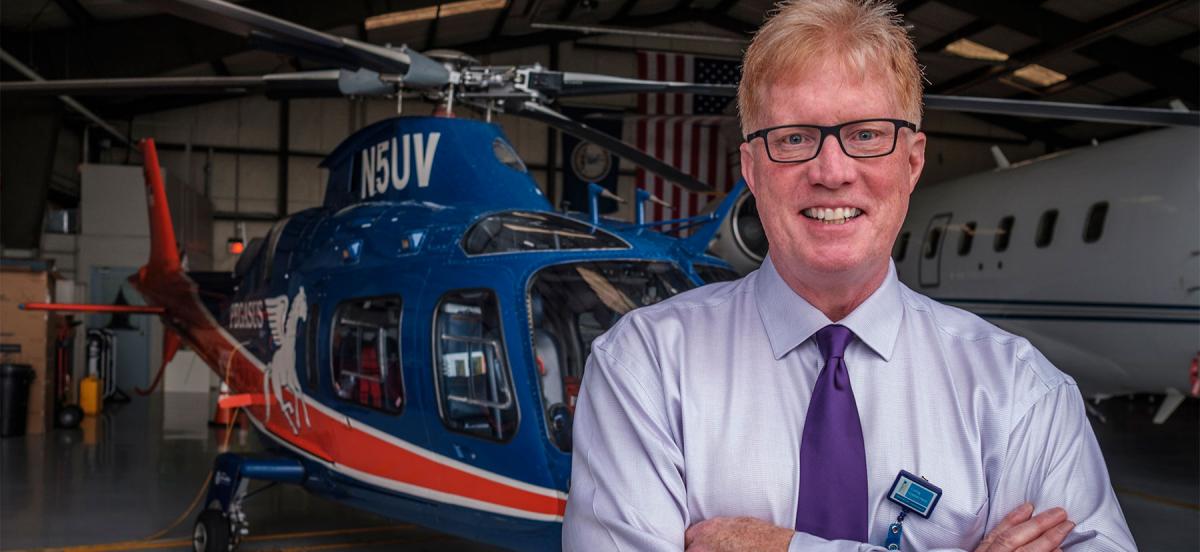Tending to the Injured in Charlottesville

Robert E. O’Connor '78 in front of UVA's Pegasus Helicopter at Charlottesville Regional Airport. Photo by Justin Ide.
Details
When the white supremacist rally in Virginia erupted in violence this summer, Dr. Robert E. O’Connor ’78, director of the University of Virginia Medical Center Hospital's Emergency Department, faced the largest multiple-casualty incident of his career.
On that terrible August Saturday in Charlottesville, Dr. Robert E. O’Connor ’78 arrived early at the University of Virginia Medical Center Hospital. As director of the hospital’s Emergency Department, O’Connor anticipated trouble. Big trouble.
An estimated 700 white nationalists, neo-Nazis, and KKK members had swept into town with a stated goal of protesting the city’s plan to remove a statue of Confederate general Robert E. Lee from Emancipation Park. Counter-protesters prepared to confront them. Though police and university intelligence projected that many would be armed, nobody predicted the car.
Around 1:45 p.m., O’Connor received an alert from the incident command center outside the hospital. A car had plowed into a group near the downtown mall, he was told, leaving as many as 10 critically injured, perhaps 10 to 15 with serious injuries, and several with minor injuries.
“That’s when I pulled the switch,” O’Connor says. “I called the command center and said, ‘Initiate an MCI’—a multi-casualty incident.”
O’Connor’s decision set in motion a plan that had been weeks in preparation. Nurses and technicians rolled stretchers, IV poles, and coolers of blood into a triage center set up in the hospital’s two-story lobby. Trauma teams waited in the hospital cafeteria. Emergency physicians manned four receiving rooms with eight beds. Imaging, surgery, and intensive care units awaited orders.
The hit-and-run occurred a mile from the hospital. The first ambulances arrived in minutes, the rest within 20 minutes, all carrying patients coded red (critical), yellow (intermediate injuries), or green (minor injuries).
Here’s how O’Connor describes the scene: “The first wave of patients comes in. They get stabilized. Then they go to imaging. Then it’s decided: Do they need the operating room or just intensive care? Or can we move them out to the floor? Eventually we got to the point where there were just green patients left—the people with broken bones or lacerations.”
Working alongside O’Connor was his wife of 30 years, Dr. Sara Sutherland, also an emergency medicine physician. Their personal and professional lives have been entwined since both were residents at the Medical Center of Delaware in Newark.
The emergency department cared for 20 people injured by the hit-and- run driver that day. Nine were admitted. Ten were treated and released. Heather Heyer, 32, did not survive.
“The whole scene was cleared in about two hours,” says O’Connor, who recalls walking into the triage area after the last patients had been treated. “There were 10 paramedics and about 30 unused IV poles, maybe two or three stretchers. It was eerily calm considering what had just taken place.”
O’Connor knew he wanted to be a doctor from an early age. He understood what the profession demanded; he was 12 when his family moved from Pittsburgh to Philadelphia, where his mother completed medical school and her residency in internal medicine.
His college experience also influenced his decision. “Haverford taught me the value of leaving something greater than yourself in this world. That’s what drew me to medicine and to emergency medicine,” he says.
Among his goals, two that O’Connor pursued tirelessly were to refine treatment practices and to help transform an overlooked specialty into one of the most prominent fields in American medicine.
In 1982, when he graduated from the Medical College of Pennsylvania, the nation counted roughly 30 emergency medicine residencies and 6,000 emergency physicians. Today there are hundreds of residencies and roughly 35,000 emergency physicians.
“When I applied for residency, I knew other students around the country who were advised by their faculty, ‘Don’t go into emergency medicine. You’ll burn out. It’s a passing fad. There’s no permanence to it,’ ” O’Connor says.
But his career path reflects how he and his field have flourished. At age 34, he became director of emergency medical research at Christiana Care Health Systems in Delaware. He also was named director of Delaware’s emergency medical service. Among his innovations: helping suppliers develop portable EKG and defibrillation equipment, and training emergency technicians to stabilize heart attack and cardiac arrest patients in the field.
O’Connor has published 160 research papers, many in the Annals of Emergency Medicine, the profession’s leading journal, produced by the American College of Emergency Physicians. He won a seat on the organization’s board, and served as its chairman in 2016. He has trained 400 emergency doctors in the United States, and dozens more in China and India.
In 2007, O’Connor moved to Charlottesville, where he became chairman of the UVA School of Medicine’s Department of Emergency Medicine and director of the medical center’s emergency department, which sees an average of 175 patients per day. “On busy days,” he says, “we see over 200. We see everyone who comes to us, so we have little control over day-to-day volume. That’s what makes the field exciting.”
All over the country, O’Connor’s peers take notice. “Bob is knowledgeable in so many areas of emergency medicine,” said Dr. Paul Kivela, president of the American College of Emergency Medicine and managing partner of the Queen of the Valley Medical Center in Napa, Calif. “The word in the EMS community is that the situation in Charlottesville was very well managed. He’s a big reason why.”
On that day in August, O’Connor directed the largest multiple-casualty incident of his career. “I don’t think of it as a defining moment for me, but a defining moment for UVA, because everything worked smoothly,” he says. “We had many moving parts come together to take care of a lot of people very quickly.”



